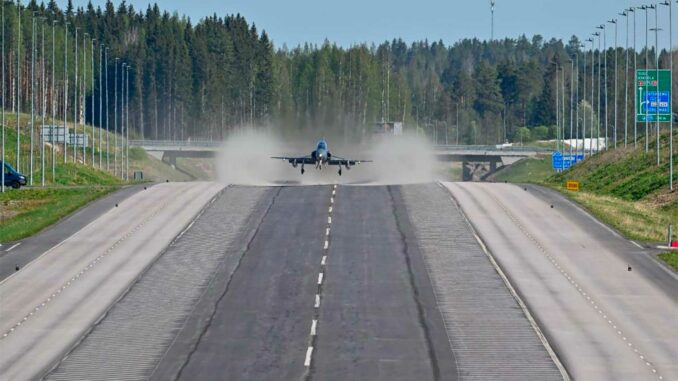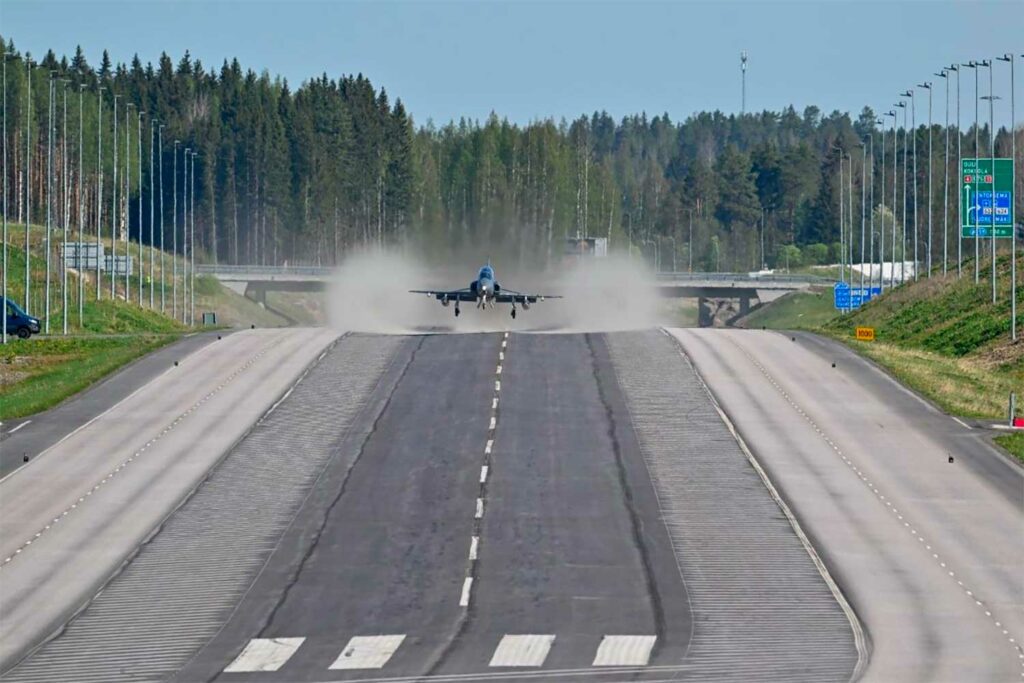
NATO is training its aircraft to take off from Finnish and Swedish roads, validating agile air deployment (ACE) tactics.
From May 26 to 30, 2025, the air forces of several NATO countries conducted highway air warfare exercises in Finland and Sweden. This operational demonstration implements the Agile Combat Employment (ACE) doctrine, which aims to strengthen the resilience of air forces in the event of a major conflict. The Finnish Air Force mobilized its F/A-18 Hornets and Hawk training aircraft from a section of the E75 highway, while Dutch F-35As participated for the first time in the Finnish “Baana” exercise. In Sweden, Norwegian, Swedish, French, and German C-130 Hercules aircraft landed on closed roads. This strategy reduces the vulnerability of air bases and maintains fleet operability in a contested environment.

The ACE concept: a tactical response to the vulnerability of air bases
Agile Combat Employment (ACE) is a strategy developed by NATO and its allies to reduce dependence on fixed bases. The principle is to disperse aircraft to secondary sites, including roads, in order to maintain their response capability even if traditional infrastructure is attacked.
Historically, fixed air bases have been priority targets in conventional warfare. Attacking a main runway can ground an entire squadron. To counter this threat, ACE relies on:
- Multiple takeoff and landing points, including reinforced sections of highways;
- Mobile light maintenance and refueling capabilities;
- Small, modular units that can be moved quickly.
The tactical benefits are significant: an adversary can no longer rely on neutralizing a few key installations to disrupt a fleet. According to the US Air Force, the ACE model reduces the probability of simultaneous neutralization of multiple aircraft during a targeted attack on a single base by 60%.
Finland leads the way: the Baana experience and the Scandinavian model
Finland has recognized expertise in dispersed air operations. Since the 1960s, the Finnish Air Force has trained its pilots to land on prepared roads. This model, known as the mobile battle concept, is based on the assumption that airfields will be vulnerable to a first strike.
From May 26 to 30, 2025, more than 2,000 personnel were involved in the JPH exercise, a national training exercise that included the Baana maneuver for the first time this year. The latter involves temporarily closing a section of the E75 national highway to convert it into an operational runway.
- Aircraft involved: F/A-18 Hornet, Hawk, liaison aircraft.
- Location: Tikkakoski, near Jyväskylä Air Base.
- Objective: to maintain operational capability in a degraded environment.
This dual civil and military infrastructure enables a rapid response in the event of an attack. In the event of conflict, the country has more than 20 sections of road converted into secondary runways. This network has been integrated into NATO scenarios since Finland’s accession in April 2023.
Multinational integration: cooperation between 4th and 5th generation aircraft
The 2025 edition of the Baana exercise also marks the first participation of the Netherlands, which has committed F-35A Lightning II aircraft. These 5th generation stealth aircraft performed touch-and-go maneuvers (landings with go-arounds) and takeoffs from Finnish roads. They also joined flights in cooperation with Finnish F/A-18s, illustrating the growing interoperability of allied fleets.
This cooperation is of strategic importance: compatibility of doctrines, identification and guidance systems, and weaponry is essential to ensure effectiveness in coalition.
The Netherlands currently has 46 F-35As based in Leeuwarden and Volkel. They are set to completely replace the F-16 fleet by 2028. The unit cost of these aircraft exceeds €82 million (approximately £70.5 million / $89 million).

In Sweden, tactical transport aircraft test civilian routes
Alongside Finland, Sweden has conducted its own air maneuvers. C-130 Hercules aircraft from the Swedish and Norwegian air forces, as well as the Franco-German BATS (Binational Air Transport Squadron) unit, carried out landings on roads closed to traffic.
The aim was to demonstrate the ability to project logistical and human resources from unconventional areas. The C-130, capable of landing on an unprepared 900-meter strip, is a key tool for supplying isolated units or exfiltrating personnel.
France and Germany, which share the BATS squadron based in Évreux, each use two to four Hercules aircraft in this joint unit. This maneuver also embodies NATO’s effort to integrate European tactical logistics capabilities into a common approach to resilience.
The strategic challenge for NATO: Article 5 and credible deterrence
Article 5 of the North Atlantic Treaty states that an attack against one member is considered an attack against all. To ensure the credibility of this clause, the Alliance must demonstrate its ability to maintain operations in contexts where its main bases are rendered unusable.
The ACE model reinforces this posture by:
- It complicates adversary offensive planning by increasing the number of points of uncertainty.
- It reduces the time needed for redeployment, making collective defense more responsive.
- It promotes modular logistics that are sustainable even without access to fixed facilities.
General Johnny Stringer, Deputy Commander of NATO’s Allied Air Command, reiterated that ACE is a fundamental operational foundation for ensuring deterrence. These exercises in Finland and Sweden demonstrate that the Alliance has the concrete means to implement it.
A model that can be extended to all of Northern Europe
The exercises carried out in May 2025 signal a doctrinal convergence around air resilience. The Nordic geography, with its long, straight roads and sparse population, is particularly conducive to this type of doctrine. Ultimately, countries such as Norway, Latvia, and Lithuania could adapt this model.
This type of training is not purely symbolic. It meets specific tactical needs and is based on proven technical capabilities: reinforced runways, aircraft certified for rough terrain, and small but operational ground crews.
NATO is thus preparing for a war in which mobility will compensate for the fragility of fixed infrastructure, and where surprise will remain a key factor in air survival.
War Wings Daily is an independant magazine.